Center of Excellence
Botany Research Sub-Group
Projects - Edible plants
GBY is one of the earliest sites to evince edible plant remains of the early Palaeolithic period. The botanical remains provide a detailed, reliable record of hominin vegetal diet during the Early-Middle Pleistocene period. These plants supply fleshy fruits, nuts, underground storage organs, and greens such as leaves, young stems and young shoots. The GBY macrobotanical assemblage enabled us for the first time to reconstruct the vegetation and food plants by studying and comparing the ancient archaeobotanical material with the modern floras around the site.
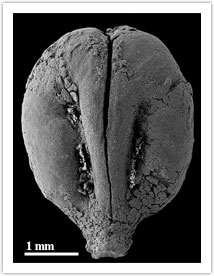 |
|
Wild grapevine (Vitis sylvestris): pip remains. It was a common fleshy fruit in the surroundings of GBY.
|
The plant remains represent two main habitats – park and riparian forest ecosystems. They act to complement each other with respect to starchy food supply; the riparian ecosystem is a source of underground storage organs mainly in the late spring and summer, while the park forest supplies nuts in autumn and early winter.
Nuts
Rich in fatty acids and protein, many nut kernels, such as those of almond (Amygdalus) and Pistacia, provide significant nutritional value. In addition, nuts supply quantities of essential fatty acids – linoleic and linolenic acids (Mathew et al., 1999). Some terrestrial Mediterranean nuts contain toxic substances, which function as a defense mechanism. They include amygdalin, which is present in Amygdalus in the form of cyanic acid and in Quercus as bitter tannins. Roasting these nuts reduces the concentration of the toxic substances or eliminates them entirely.
Seven fruit-bearing species with edible seeds protected by a hard shell were found in the sedimentary sequence at GBY: 1. Prickly water lily, 2. Atlantic pistachio, and 3. water chestnut are part of the fruit assemblage; and 4. almond, 5. pistachio (Pistacia vera), 6. Quercus calliprinos, and 7. Q. ithaburensis were identified in the wood assemblage. Nuts of all seven species cannot be readily opened without a tool (Goren-Inbar et al., 2002).
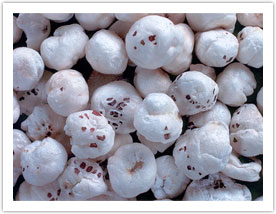 |
|
Puffed seeds of prickly water lily (Euryale ferox)
|
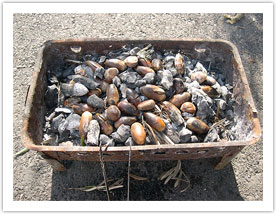 |
|
Acorns of Q. Itaburensis are prepared like chestnuts.
|
The oak tree in modern Israel is present in two of the most important local forest types, evergreen forests and deciduous, open forests. Many oak species have edible acorns, and numerous cultures throughout the world have consumed them as a staple food (Mason, 1995). The edible acorns of Quercus ithaburensis are the most common nuts in the region of GBY today and were also common in the Lower Palaeolithic. Together with Q. calliprinos, Q. ithaburensis was the main nut species that was available to the hominins at GBY.
Other sources of vegetarian food
Other important sources of food are the fruits of wild fig, grape, hawthorn (Crataegus), jujube, myrtle (Myrtus), and pear (Pyrus), as well as rootstocks such as that of cattail. Based on the palaeobotanical finds of GBY, we suggest a diet that includes plant food throughout the year.
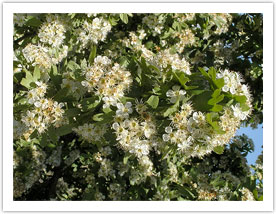 |
|
Mediterranean hawthorn (Crataegus azarolus) flowering in the spring
|
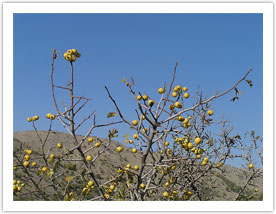 |
|
Mediterranean hawthorn supplies a lot of tasty fruits during the autumn
|
The edible plants are also hint at seasonality of occupation; so far it has been noted that plants in most layers represent three seasons and sometimes all four.
|